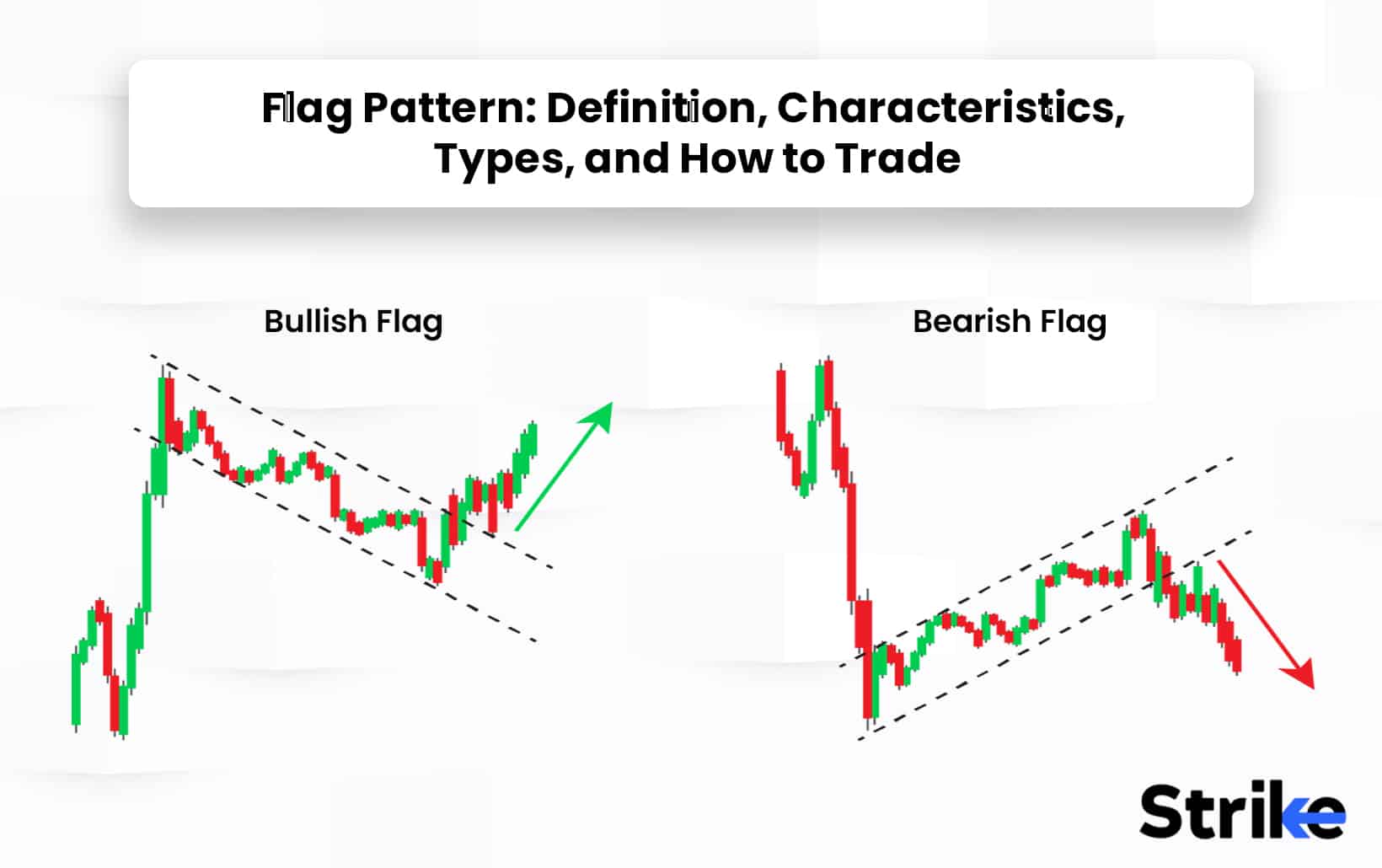
The flag pattern signals that the previous trend may continue after this brief consolidation period or minor correction. Flag patterns are controlled by representative volume indicators as well as price action. The flag has a body and a flag pole. The pattern is used to identify the possible continuation of the previous trend from a point at which price has departed against the same trend. It is characterized by a rectangular or parallelogram shape, formed by two parallel trend lines that are drawn to connect the highs and lows of the price chart and the rectangle is connected to the flagpole, which is quick and large to move. The pattern originated in the middle of a larger price trend and is considered as a continuation pattern that the trend is likely to continue in the same direction after a long period of consolidation.
Traders use flag patterns to identify potential trading opportunities as they show a strong trend that is to continue. There are mainly 2 types of flag pattern in trading: The Bull flag andThe Bear flag. A bull flag pattern occurs after a strong upward price movement and the bear flag pattern occurs after a strong downward price movement.
The flag pattern is a technical analysis chart pattern that has mainly 6 distinct characteristics such as strong trend, consolidation, parallel trendlines, volume, breakout, and target price. Traders can use flag patterns to anticipate potential trading opportunities and manage their risk. A trader can introduce a strategy for trading such patterns by identifying the main three key points that are entry, step loss, and profit target. Flags is seen in any time frame but normally contain about five to fifteen bars. It is a price pattern where the frame moves in a shorter time counter to the overcoming price trend looking in a longer time frame on a price chart.
What Does a Flag Chart Pattern in Technical Analysis Mean ?
A Flag pattern is formed when the price of a stock or asset rises rapidly in a short period of time called the flagpole. Flags are categorized as continuation processes and represent only brief pauses in a dynamic market.
A rectangular shaped consolidation pattern will form before continuing its prior trend. A flag pattern typically occurs after a strong price move in a particular direction in technical analysis. The pattern is seen as a pause or a rest period where the market takes an interval before resuming its previous direction.
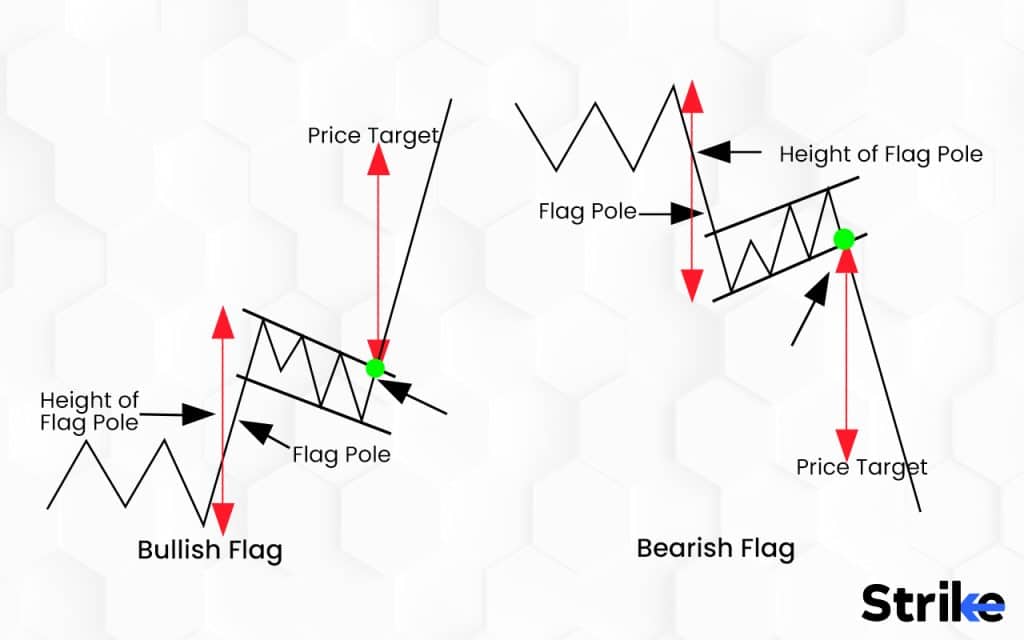
There are mainly two types of flag chart pattern: Bullish chart pattern and Bearish chart pattern. A bullish flag pattern signals a continuation of an uptrend and bearish flag pattern suggests a continuation of a downtrend. It has a downward slope after an uptrend and It has an upward slope after a downtrend. The preceding trend is crucial for pattern formation.
The key way to trading flag patterns is to look for a breakout above or below the flag pattern. A buy signal is considered as the upper boundary of the breakout above and sell signal is considered as the lower boundary of breakout below.
What is the other term used for a Flag Chart Pattern ?
The Flag pattern is one of the most popular chart patterns formed by price action which consists within a small rectangle or a channel in the shape of a flag. The flag chart pattern is also known as a “flag and pole’’ pattern or simply a flag pattern. The pole refers to the initial strong price movement that forms the vertical line, while the flag means the consolidation period that forms the horizontal line. These lines together form a flag-like shape which indicates a continuation of the prior trend. Flag chart patterns are a great set up for new traders to learn because they are easy to spot and trade once they understand the mechanics behind them.
How does a Flag Pattern in Technical Analysis Work ?
A Flag pattern refers to a situation where the price of a financial asset moves within a narrow range without making any significant highs or lows. Flag patterns are generally considered to be an integrated phase in the market, where the buyers and sellers are in the state of equilibrium. There is no clear trend direction in this phase. Traders look for specific price levels during a flag pattern, where the price has bounced back off multiple times signaling support and resistance levels. A way to trade a flag pattern is to wait for a breakout which occurs when the price moves outside of the range that it has been trading in. Breakout indicates a new trend direction because traders look for breakout above resistance level or below support levels.
Another way is to use oscillators like Relative Strength Index, Moving Average Convergence Divergence etc. These can help to identify oversold conditions and it could signal a potential breakout. Not all flag patterns result in a significant trend reversal. Traders should use different indicators and technical market analysis to make informed trading decisions.
Why is Flag Pattern important in Technical Analysis?
The flag pattern is important as it provides valuable insights into market trends and historical price movement. It is a pattern that forms whenever there is a sharp rise or drop which occurs by a narrow price range trading, and finally completed by another sharp rise or decline. It is used to identify the possible continuation of a prior trend from a point at which the price has drifted against that in the same trend. These patterns are more reliable continuing patterns among others that traders use because they create a setup for entering an existing trend that is ready to continue. Flag patterns can provide information about support and resistance levels so it helps traders to take accurate trading decisions and can understand the future of the market.
What are the Characteristics of Flag Chart Pattern ?
Flags are areas of tight unification in price action showing a counter trend move that follows directly after a sharp directional movement in price. Flag patterns are either upward or downward trending. The bottom of the flag should not exceed the midpoint of the flagpole that predates it. Flag patterns have main five characteristics.
- The preceding trend: Bullish and Bearish patterns have similar structures but different in trend direction and precise differences in volume pattern. The bullish volume pattern increases in the preceding trend and decreases in the consolidation, but in the bearish volume pattern increases first and then tends to increase in the volume as time progresses.
- The consolidation channel: A flag pattern also characterized by parallel markers over the consolidation area. The patterns are referred to as a wedge pattern when the lines converge.These patterns are more reliable patterns that traders use because they create a setup for entering an existing trend that is ready to continue. The formations are all similar and lead to show up in an existing trend.
- The volume pattern: The flag chart pattern also follows the same volume patterns. The patterns are characterized by declining trade volume after an increase in the beginning. This hints that the traders pushing the prevailing trend have less urgency to continue their buying or selling during the consolidation period. Thus setting up the possibility that new traders and investors will take up the trend with interest, driving prices higher at a pace quicker than usual. The price moves are characterized by higher than average volume patterns. The price target for a flag pattern is calculated by measuring the length of the flagpole and adding it to the breakout point.The flag chart pattern can provide traders with useful information about the market’s direction and price movement.
- A breakout: The price breaks out of the consolidation period in the same direction as the previous trend and the flag pattern is confirmed.
- Price targets: The price target for the flag pattern is calculated by measuring the length of the flagpole and projecting it in the direction of the breakout.
The flag pattern is a reliable continuation pattern that can provide traders with a clear entry and exit strategy.
What Happens After a Flag Pattern?
The main speciality of the flag pattern is that the price usually continues in the same direction as the initial price move known as the flagpole after a flag pattern. That is why this pattern is considered as a continuation pattern. The pattern is usually seen as a pause in the trend. Traders look for confirmation that the breakout is valid before making trading decisions once the price breaks out of the flag portion of the pattern. The flag pole and a flag once formed the traders should watch for the price to breakout above the upper flag or trend line. The pattern is completed when the price breaks out of the consisting trend lines in the direction of the prevailing trend, at which point it will continue its course.
The bear flag helps sellers to push the price action further lower as a continuation pattern. The bull trend that already exists and the price will increase after the pattern is finished. Traders use a flag pattern as an indicator to enter a trade in the direction of the breakout with a stop loss placed below the bottom of the flag or above the top of the flag. The breakout from the flag chart pattern happens on high trading volume. Traders also use technical indicators or fundamental analysis to confirm the validity of the indicator before entering a trade.
How does Flag Pattern differ from other Chart Patterns?
A Flag pattern is a type of chart pattern that occurs after a sharp price movement in both directions. The pattern represents a period of consolidation before the price continues in the same direction. Flag patterns are mainly shorter in duration and less complex in their structure and the pattern has continuation whereas other patterns will signal a reverse in the trend while compared to other patterns such as double tops, double bottom and triangles, head and shoulders.
Flag patterns provide more clearer and reliable signals than other chart patterns. Flag patterns occur as a result of profit taking after a strong move, which can signal that market participants are still confident in the direction of the trend so the pattern is stronger and decisive than others. Flag pattern is a very useful tool for traders and analysts to identify potential opportunities for entering or exiting a market position.
What are the types of Flag Pattern ?
A Flag pattern is a trend continuation pattern and typically consists of between five and twenty price bars. The pattern of the flag chart pattern looks similar to a flag or a flag pole. There are mainly two types of flag chart patterns based on their structure and potential. They are the Bearish flag and the Bullish flag, which are opposite to each other.
1. Bear Flag Pattern
A Bear flag pattern is a continuation pattern that occurs after a strong downward price movement. The bear flag is an upside down version of the bull flag and it has the same structure as the bull flag but it is inverted. It is characterized by a period of consolidation in which the price moves sideways or slightly higher.
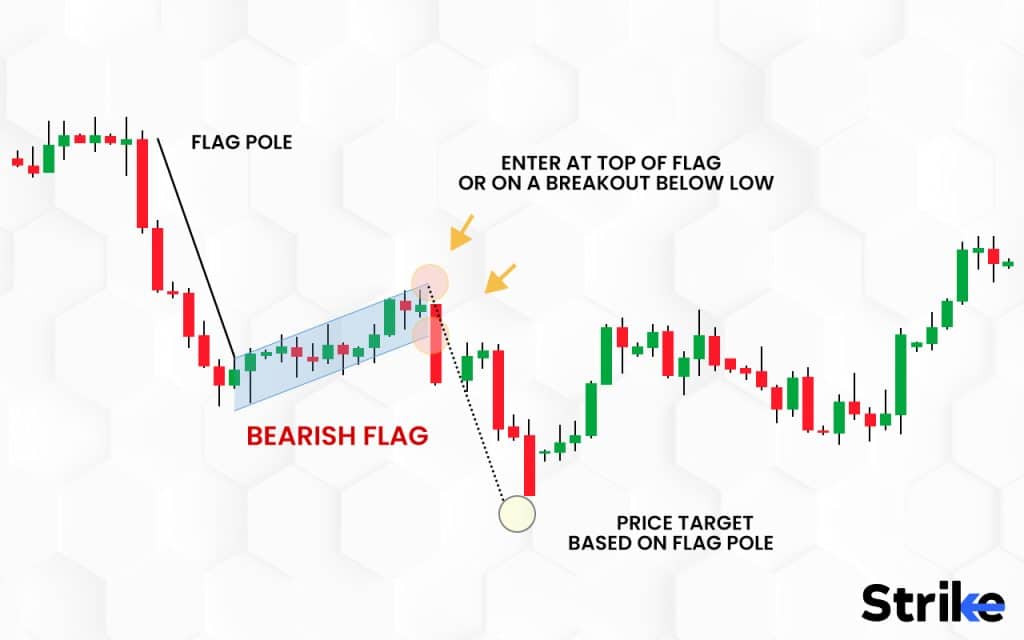
The bear flag resembles a small rectangle or parallelogram consisting of two parallel trend lines connecting the highs and lows of the price action. The flagpole structured on an almost vertical panic price drop and hit unexpectedly from the sellers, and then bounce it in a parallel upper and lower trend lines which form the flag. The lower trend lines break and cause panic sellers as the downtrend resumes another movement to the lower position. The severity of the drop on the flagpole decides how strong the bear flag is The sell off in the beginning comes to an end through some profit taking and creates a tight range making slightly higher lows and higher highs. Bear flags become stronger when the swing low that begins the pattern is also at an all time low due to the possible lack of underlying support. The success of a bear flag becomes greater after an important downside move due to the possible increase of overhead resistance.
2. Bull Flag Pattern
The Bull flag pattern is a type of flag chart pattern that suggests an uptrend. The pattern occurs after a strong upward price movement and it is characterized by a period of consolidation in which the price moves slightly lower. The pattern begins with the strong almost vertical price projection that takes the short sellers completely off guard as they cover in mania as more buyers come in off the fence. This flag pattern also resembles a small rectangle or parallelogram with two parallel trend lines connecting the highs and lows of the price action like the bear flag pattern.
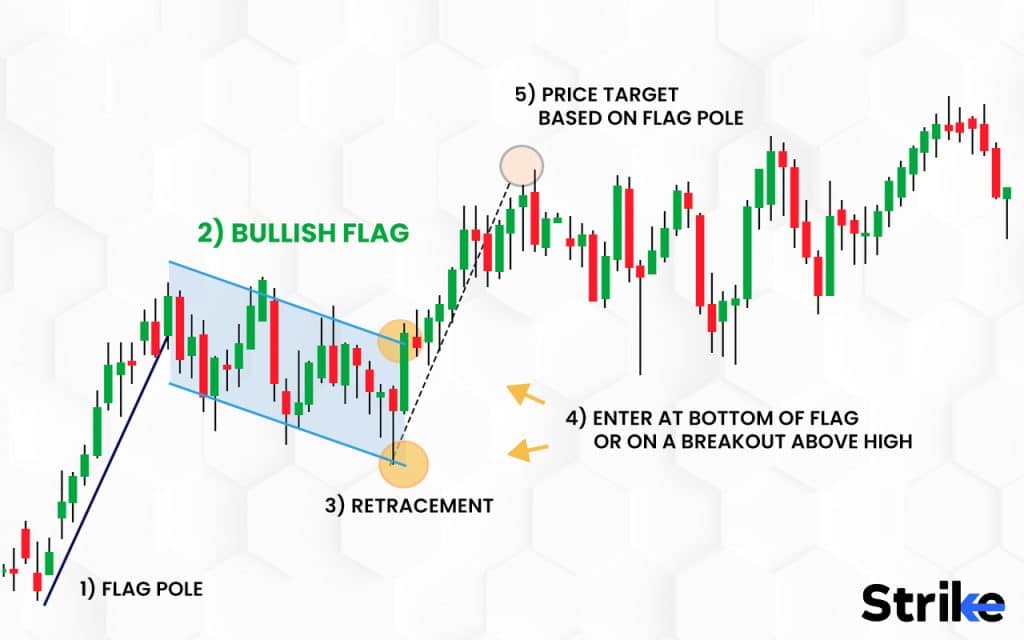
A breakout above the upper trend line of the flag is a bullish signal, signaling the price is to continue its upward trend. The sharper the spike on the flagpole the more powerful the bull flag is. There is great enthusiasm to buy on the move upwards than on the move downwards during the bull flag pattern. Bull flag trading is quite simple but the hardest part of trading in this pattern is to find it in real time. The bullish flag pattern increase in supply stops the price to rise, and forms a flag pattern due to this the price swings down. The price breaks outside the flag above the resistance, and prices continue to move upwards when the demand is more than the supply. The bull flag patterns are a great setup for new traders to learn because they are easy to spot and trade once the trader understands the mechanics behind them.
How to Trade a Flag Pattern?
The flag pattern is a popular chart pattern used in technical analysis. Traders can enter into a trade when the price breaks above or below the upper or lower flag trend lines. The main step is to look for a sharp price move followed by a consolidation period that forms a flag shape to trade for flag patterns.
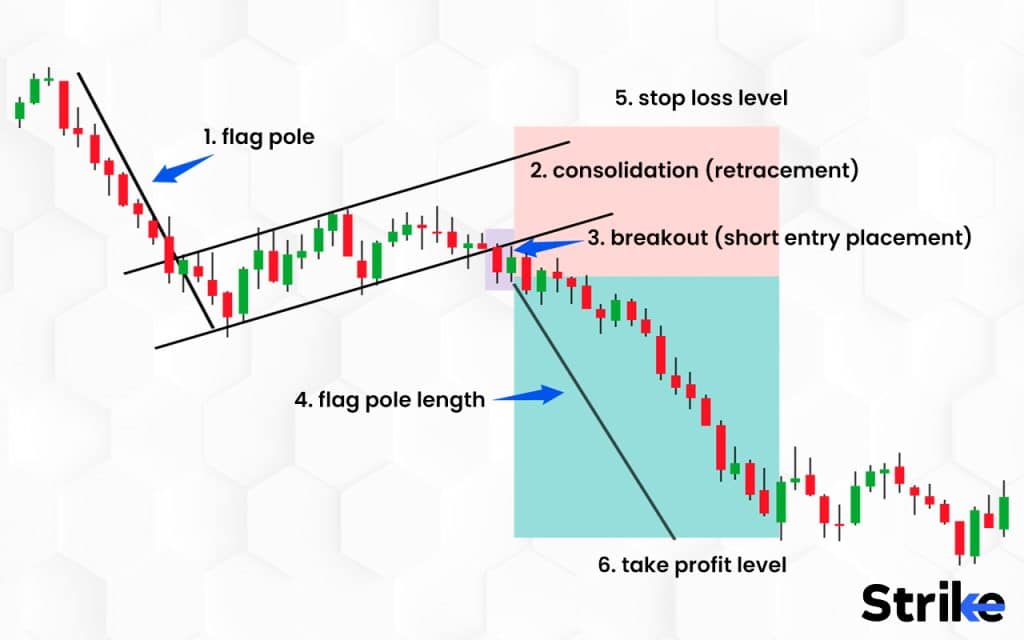
A Trader can establish a strategy for trading flag patterns by identifying three key points. They are entry, stop loss and profit targets.
- Entry: Flag suggests a continuation of the current trend but it is judicious to wait for the beginning breakout to avoid a false indication. Traders expect to enter a flag on the day after the price had declined and closed above the upper parallel trend line.
- Stop-loss: Traders look to use the opposite side of the flag pattern as a stop loss point. The initial stop loss is placed under the upper trendlines on uptrend and lower trendlines on downtrends.
- Profit target: Traders who are conservative want to use the difference, measured in price, between the flag pattern’s parallel trend lines to set a profit target.
Traders should pay close attention to position size choices and overall market trends to maximize success on using flag patterns to guide trading strategies in addition to the main three keys. A trader who enters into the trade should monitor it closely to see the price continues in the direction of the breakout. The trader can consider moving his stop loss or break even or trailing it to lock in profits when the trade goes in his favor.
A trader wishing to trade the bull flag should wait for price to break out over consolidation resistance so that the trader can seek an entry. The breakout means the trend before its formation is in continuation. The trader who wishes to trade a bear flag should adopt a wait and watch policy till the price breaks below the consolidation support that the trader can find entry into the market.
What Trading Strategy is Best For a Flag Pattern?
The best trading strategy for a flag pattern depends on the trader’s preference, risk tolerance, and market conditions. There are mainly three common trading strategies for flag patterns :
- Breakout strategy : The strategy involves buying or selling when the price breaks out of the flag pattern. This strategy is suitable for traders who like to trade momentum and can handle the volatility that follow a breakout.
- Pullback strategy : pullback strategy involves waiting for the price to retrace to the flag pattern’s lower trendlines before entering a long position or the upper trendline before entering a short position. This is suitable for traders who prefer to enter trades at better prices and can wait for the retracement to occur.
- Range trading strategy : This strategy involves buying at the lower trendlines and selling at the upper trendline of the flag pattern. Range trading strategy is for traders who prefer to trade range-bound markets and can handle the price fluctuations within the flag pattern.
It is essential to have a well defined trading plan, risk management strategy, and discipline to execute the selected strategy most effectively.
What Time- Frame is Best to Trade a Flag Pattern?
The timeframe that is best for identifying flag patterns depends on the trading style and goals of the trader. The flag pattern is most commonly used on shorter time frames such as the 1 hour or 4 hour charts. The flag pattern is a technical analysis chart pattern that occurs when there is a sharp price movement in a particular direction followed by a consolidation where the price moves sideways, forming a flag-like structure. Here the patterns can form quickly and provide opportunities for short term trades.
It is significant to keep in mind that shorter time frames is more volatile and require more frequent monitoring. Longer term traders prefer to use the flag pattern on longer time frames because it can provide a more reliable signal of a longer term trend. Traders also use this pattern to identify potential entry and exit points for longer term trades or to confirm existing trends. It is important to use multiple timeframes to confirm the validity of the pattern before making trading decisions.
What is the Price Target for Flag Pattern?
The price target is used as a guide for setting profit targets and examining whether the trade is worthwhile or not. A price target for a flag pattern is a level at which a trader expects the price to move after the pattern has completed. There are several methods that traders use to determine a price target for a flag pattern. Flagpole is a common method used to measure the distance of the initial price movement and project that distance from the point of the breakout from the flag pattern.
Another method for measuring price target is to look for a previous level of support and use that as a price target. Traders also use technical indicators such as fibonacci retracement; it uses ratios based on the fibonacci sequence to identify levels of support and resistance. It is significant to keep in mind that price targets are not guaranteed. Market cannot move in the expected direction, so traders should also use stop-loss orders to limit their risk and protect against unexpected market movements.
How Reliable a Flag Pattern in Trading?
Flag patterns are considered one of the most reliable patterns that traders use in their technical analysis. The reliability of a flag pattern in trading depends on mainly 4 factors such as the timeframe, the market conditions, the trader’s ability to identify and interpret the pattern accurately. Mostly the flag patterns are considered to be reliable chart patterns because they indicate a continuation of the trend that introduces the pattern.
False breakouts are the major problem faced by flag pattern. False breakout occur when the price breaks out of the flag pattern and quickly returns back inside the pattern. Traders can improve the reliability of the flag pattern by using different technical analysis tools such as moving averages, trendlines, volume indicators to confirm the validity of the pattern. Overall market conditions such as economic data releases, geopolitical events, etc are important to consider so that these affect the asset being traded. Traders should always use caution and manage their risk appropriately to make the trade decision better.
What is the Success Rate of Trading Flag Patterns?
The flag patterns are generally considered to have a higher success rate compared to other chart patterns. The flag pattern has an approximate success rate of 70%. This shows that in about 60-65% of cases the price moves in the expected direction after the pattern has completed. The bullish flag pattern success rate of 67.13% appears similar to a horizontal parallel channel paired with a strong bullish vertical rise.
False breakouts and a trader’s ability to correctly identify and interpret the pattern will affect the success of the flag pattern in trading. The success rate of flag patterns depends on market conditions, time frame, the trader’s skill level, and the risk management. A successful trading needs a combination of technical analysis skills, market knowledge, and discipline.
Is It Worth It To Trade a Flag Pattern?
Yes, A Flag pattern is a weak drop of an existing trend shown in the form of small-bodied candles. The main advantage of trading flag patterns is that they can offer a good risk to reward ratio because traders can set their stop loss orders below the low of the flag pattern which can limit their risk.
Another advantage is that flag patterns is used in a variety of markets including stocks, forex, and commodities. This makes the traders a flexible trading strategy. Flag patterns are profitable trading strategies but they are not suitable for all traders and market conditions. The best time to trade the flag pattern is after the breakout or during a strong trending market.
What type of indicator can be used with a Flag Pattern?
Flag patterns are followed by representative volume indicators and price action. Flag patterns signify trend reversals after a period of consolidation. Traders can use a variety of signals in combination with a flag pattern to help confirm its validity and improve the chances of a successful trade. Moving averages, Relative strength index, Bollinger bands, Volume indicator, On balance volume, Fibonacci retracement are the main indicators used with the flag pattern.
Moving averages can help the traders to identify the trend and confirm the legitimacy of the flag pattern. The Relative strength index helps traders to identify oversold conditions. It indicates potential buying opportunities while an oversold relative strength index can signal potential selling opportunities. Bollinger bands indicate a potential trading range when a breakout from the bands can signal a potential trend continuation and helps traders to identify volatility. On balance volume confirms the validity of the flag pattern by identifying rise or fall in the trade volume.
Higher volume signals can confirm the validity of the pattern and the lower volume signals indicate a false breakout. Fibonacci retracement levels help the traders to identify the potential support and resistance level and confirm the validity of the flag pattern. It helps the traders to set their profit targets and stop loss targets. The indicators help the traders in combination with the pattern to confirm the sustainability and improve the chances of a successful trade.
Can a Moving Average (MA) be used together with a Flag Pattern?
Yes, A Moving Average (MA) is used together with a flag pattern to help traders to identify prospective entry and exit points. MA confirms the direction of the trend and manages risk. It is a popular tool in technical analysis that can help smooth out price fluctuations and identify the overall direction of the trend.
A trader can use shorter term MA to identify the short term trend and a longer term MA to identify the long term trend. The shorter term moving average crosses above the longer term moving average can indicate a probable uptrend and a crossover below can indicate a probable downtrend. Traders can use moving averages to manage their risk by arranging their stop loss orders just below the moving average. This can limit the risk of the price moving in the opposite direction.
Is it possible to trade Flag Pattern with Fibonacci Retracement?
Yes, it is possible to use fibonacci retracement levels to trade the flag pattern. Traders draw a fibonacci retracement tool from high to low of the prior price move to use fibonacci retracement levels with the flag pattern. Then they look for the flag pattern to form within the retracement levels, normally at the 50% retracement level.
The traders look for a breakout above the flag to confirm the continuation of the original trend, when the flag pattern forms within the retracement levels. Traders also use fibonacci extension levels to set price targets for the continuation move. But it is better to use multiple technical analysis tools and indicators in combination with the flag pattern and fibonacci retracement to make more informed trading decisions.
What errors do traders frequently make while trading a Flag Pattern?
Traders can make a variety of errors when trading the flag pattern. There are mainly 5 errors that happen while trading a flag pattern. The most common mistake traders make is jumping into a trade too soon before the pattern is confirmed. It is important to wait for the pattern to fully develop and for a breakout to occur before taking a position. Traders misidentify a flag pattern or mistake it for another pattern leading to incorrect trading decisions. It is significant to understand the characteristics of the flag pattern and confirm it using technical analysis tools.
Risk management is crucial in any trading strategy and traders can fail to use stop loss orders or proper position sizing when trading the flag pattern. This can lead to large losses when the trade doesn’t go as planned The flag pattern is a continuation pattern and traders need to consider the broader market context when trading it. The flag pattern is more led to a continuation of the trend when the market is in a strong uptrend or downtrend.
Traders become too focused on the flag pattern and fail to consider other technical indicators or market fundamentals. It is important to use the flag pattern in concurrence with other analysis tools to make more informed trading decisions.
How to manage risk when trading the Flag Pattern?
There is always a level of risk involved with any trading strategy. It is always worth paying attention to risk management as a part of the trader’s strategy as a continuation pattern. A trader should always define the amount or risk that they are willing to take on before entering into a trade. Setting a stop loss order at a predetermined level to limit the future losses when the trade goes against the trader. It is important to use proper position sizing when trading the flag pattern.
Determining the amount of capital traders will allocate to the trade based on the risk tolerance and account size. Confirming the pattern is critical before entering the trade. A trader should always wait for the flag pattern to confirm with a breakout in the direction of the trend. Market conditions can impact the effectiveness of the flag pattern. A trader should consider market volatility and news events that could impact the price action of the asset that is trading. It is important to have a plan for exiting the trade before entering it.
This means setting a profit target and sticking to it as well as having a plan for exiting the trade if it doesn’t go as planned. A trader should keep an eye on the overall trend. These are the main tips a trader can use to effectively manage the risk when trading the flag pattern and increases the chances of success in the market.
What is an example of Flag Pattern inTrading ?
The flag pattern is a continuation formation that can appear during a brief pause in either a bullish or bearish trend.
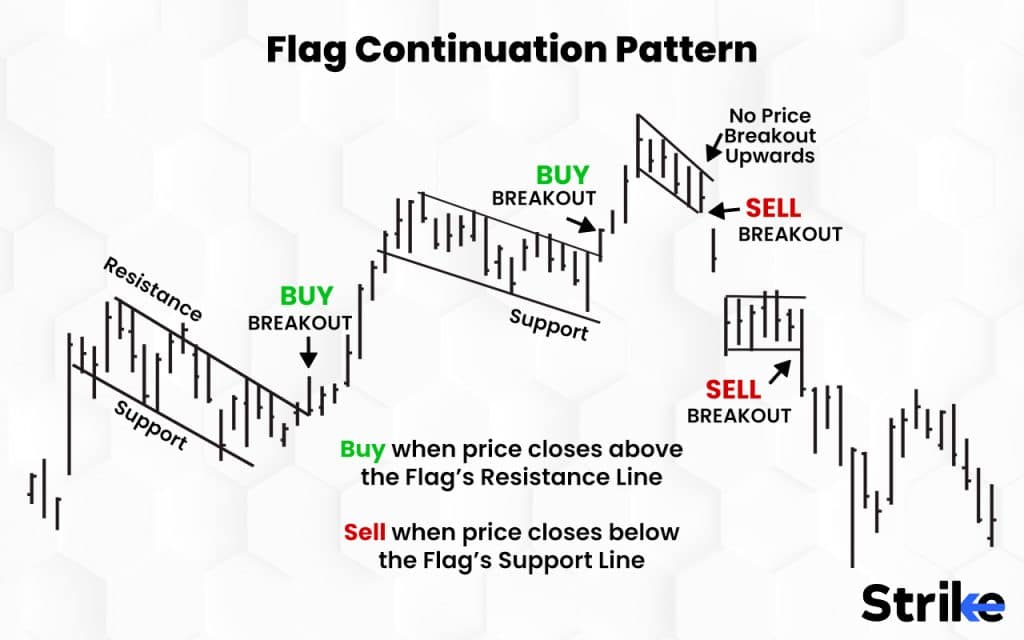
The chart example above shows the bullish flag pattern that formed in the USD/ CAD currency pair. A Flag pattern in trading refers to a period of consolidation where the price movements are limited within a range and there is no clear trend in either direction. Example: The stock of XYZ company has been trading between $50 and $55 per share for the past two weeks, with no clear indication of an upward or downward trend. Traders choose to take a wait and see as the stock is not exhibiting any clear signals for a potential buying or selling opportunity during this period.
Flag patterns are identified by looking at price charts and observing periods where the price appears to be moving sideways or forming a horizontal trading range in technical analysis. The volume does not always decline during the consolidation in a bearish flag pattern. Downward trending price moves are driven by investor fear and anxiety over falling prices are the reason for this.
Is a Flag Pattern Bullish ?
Yes, The flag pattern are either bullish or bearish. The bullish flag pattern occurs in an uptrend, characterized by a unification period where the price moves in slightly downward direction followed by a breakout to the upside. The breakout is complemented by higher volume which can confirm the bullish signal. The stock consolidates near the top of the pole on lighter volume, forming the flag in a bullish flag pattern.
Is the Flag Pattern a Continuation Pattern ?
Yes, A continuation pattern in the financial markets is an indication that the price of the stock or other asset will continue to move in the same direction even after the continuation pattern completes. The flag pattern is generally considered as a continuation pattern in technical analysis. It is an area of unification which shows a counter trend moves that follow after a sharp price movement. The pattern is identified by price action that moves between two parallel trend lines that slope up or down.
Can Flag Patterns Be Found on any Time Frame Chart ?
Yes, flag patterns are found on any time frame chart, including daily, weekly, monthly, and intraday time frame. The flag pattern is a popular technical analysis tool used by traders to identify potential price breakouts or breakdowns. The pattern is characterized by a sharp price move followed by a consolidation period which is a small rectangular pattern that slants against the direction of the flagpole. The duration and significance of the pattern will vary depending on the time frame used. The best time to trade the flag pattern is after the breakouts or during a strong trending market.
Does Trading Flag Pattern Work For Beginners ?
Yes, Trading flag patterns are useful strategies for beginners who are just starting to learn about technical analysis and chart patterns. Flag patterns are easy to identify and can provide clear entry and exit points for trades. The flag pattern is used on a variety of time frames which is helpful for beginners who are experimenting with different trading styles.
Traders should first learn how to identify them on a price chart involving looking for a sharp price move followed by a period of consolidation to trade the flag patterns. Traders also look for potential entry and exit points based on the direction of the breakout after that. Beginners should always exercise caution when making trades and follow proper risk management techniques to limit future losses.
What is the Difference Between Flag Pattern and Pennant Pattern ?
Both the patterns are considered as continuation patterns but the difference is in their shape.
The pennant pattern is identical to the flag pattern. The difference is that the consolidation phase of a pennant pattern is characterized by converging trend lines rather than parallel trend lines. Flag patterns are represented by a sharp price move called the flag pole and the consolidation is usually a small rectangular pattern that slants against the direction of the flagpole. Pennant patterns are distinguished by a sharp move followed by a period of unification but in a triangular shape that defines the pattern converging towards each other



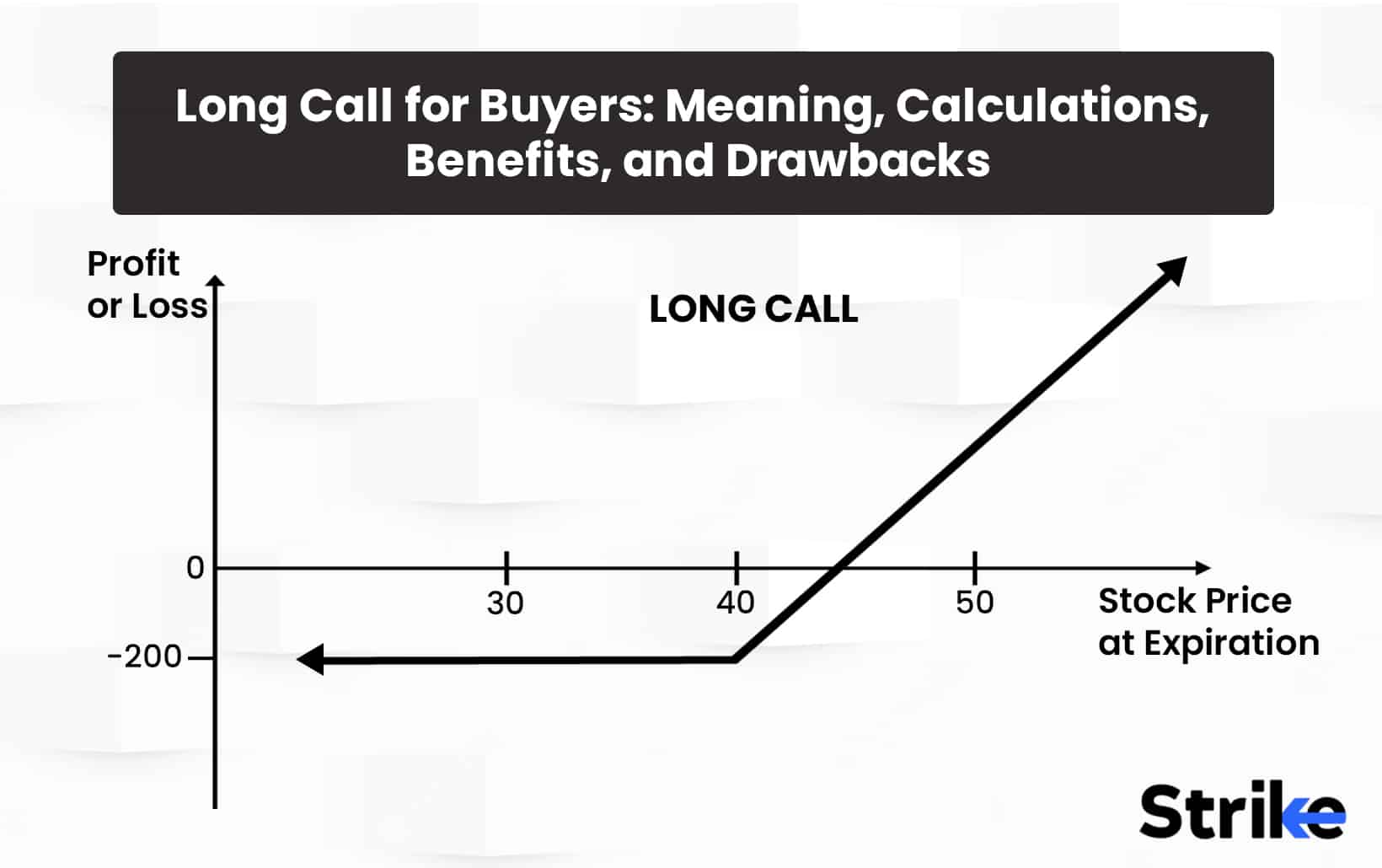
![85 Common Stock Market Terminologies for Dummies [Updated List for 2025] 64 85 Common Stock Market Terminologies for Dummies [Updated List for 2025]](https://www.strike.money/wp-content/uploads/2025/04/Popular-Stock-Market-Terms-for-Beginners-Banner.png)











No Comments Yet.